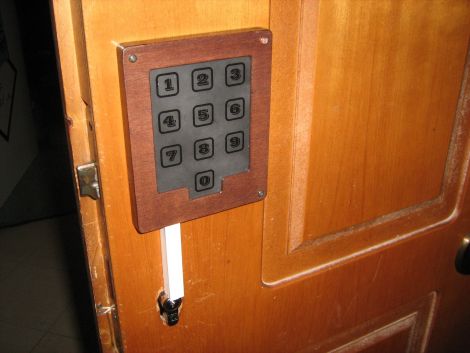
Since he was a kid [Giorgos Lazaridis] has always loved the idea of having an electronic door locking mechanism, and now that he has the means, he’s decided to construct one for securing the door to his apartment. He calls the project “simple and cheap”, though we’re not sure about the first part. Taking a look at his very detailed build log, you can see that he has invested quite a bit of time and effort into this impressive project.
Buying an off the shelf product was expensive and not a whole lot of fun, so [Giorgos] disassembled his door’s locking mechanism to see how he might be able to actuate the lock electronically himself. With minimal modifications to the lock, he was able to add a servo which reliably opens the it when triggered.
With the mechanical portion of the project out of the way, he spent a great deal of time working on the door’s electronic components, including the PIC-based controller and capacitive keypad. The keypad proved to be a bit of a problem, but after a few revisions he found a design that was both reliable and pleasing to the eye.
The locking mechanism works pretty well, as you can see in the video below, and [Giorgos] is quite pleased with the results.
[youtube=http://www.youtube.com/watch?v=0LPV2R9lLlY&w=470]














Personally I secure my doors to my apartment using hinges.
Nice :)
Good idea. Shame the servo actuated lock must have the key in it to work just a simple case of smashing away the mechanism and turning if you want to unsecure his apartment
Sorry I get so easily confused no key whatsoever just a good idea.
*golfclap*
Hmm, I purchased all the parts to install an RFID/keypad lock with a “fail-safe” (meaning if power goes out AND the battery backup fails, the door will unlock) solenoid catch and battery backup for like $50 total on ebay.
But I definitely respect the DIY approach, just probably not really cheaper. Maybe I’m not much of a hacker spirit, but if it is more expensive and more difficult/time consuming, I just go off-the-shelf and save my projects for things that save me money and time.
Now, if that door is a mortise style lock, then yeah, that it is way more expensive unless you install a deadbolt.
very nice but that white thingy kinda ruins it.
neat. my apartment building has electric locks. they seem very unsecure. but i suppose the cardboard filled 1/8inch plywood doors dont exactly require a great lock. thats why im glad i live in a Castle state
Neat, I guess. When I was a kid, I too dreamed of having an electronic lock for my door.
Now that I’m all grown up, I’ve installed a self-contained Schlage unit that does just that. It wasn’t particularly expensive, and it runs on batteries for a year or two of several-times-a-day use, and it accepts an old-fashioned key in case it doesn’t work for some reason.
It’s also directly exposed to the weather, and has shown no signs of rot after a few Ohio winters. And the rubber keypad works fine with gloves on, or when glazed in ice. And it looks like it belongs there.
Hacks are cool when they’re novel or unique, but this is neither. Electronic locks are old hat. Combing a capacitance-sensing keypad with an electronic lock is just a solution looking for a problem, and the problem doesn’t seem to exist.
What’s next: Build your own 10-digit solar-powered electronic calculator, “simple and cheap”?
darn flamers… nice hack there, the white strip is really ugly and doesn’t fit the appearance, but all in all very well done.
Of course it could have been bought instead of hacked together, but now he knows how to construct an electronic doorlock. Another thing learned. For me, that’s what hacking is half about. Half saving money and doing cool stuff, the other half learning how things work inside.
@cutandpaste i bet you’ve never solve a problem efficiently in your life. Otherwise, you would not talk about the Ohio weather, would you? What if someone makes a DIY Mars Rover and send it to Mars? It is not novel neither unique. I think the problem with you is that your sight is limited to the 25 inches required to watch a youtube video.
It occurs to me that number keypads should use LCD screens or similar to display the numbers in a random order each time you use them. That way it would be much harder for someone to watch the numbers you typed or check where the greasy finger marks are to get the likely numbers
Cool are u sharing those codes?? Bdw r u using MPLAB to encode?? Pic files??